Top News
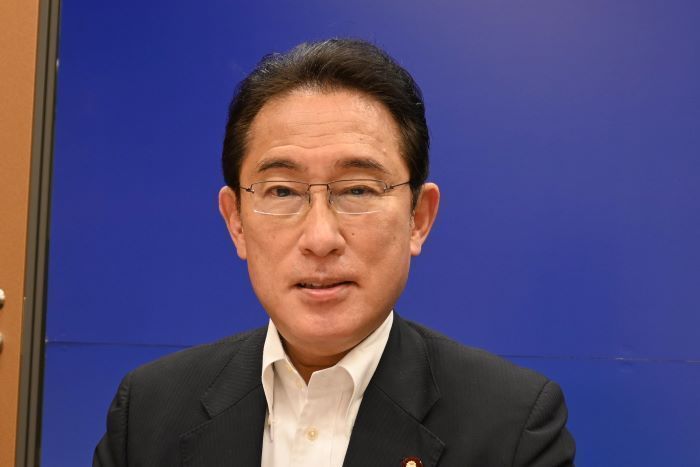
December 7, 2021 Ryukyu Shimpo
By Yosuke Anri
Prime minister Fumio Kishida gave a general policy speech on December 6, his first since the formation of his second cabinet. In the speech he clarified his position on proceeding with the relocation of MCAS Futenma to new base facilities in Henoko, and stated that, “We are working on building a strong Okinawan economy,” as part of foreign diplomacy and national security. As Okinawa looks toward the 50th anniversary of its reversion to Japan next year, the prime minister has made his stance clear that economic promotion in Okinawa is linked to the “base problem.”
Kishida touched on “Island Defense,” a topic the previous prime minister, Yoshihide Suga, refrained from commenting on, indicating that he intended on increasing defensive capabilities such as securing missiles that have “the capability to strike enemy bases.”
Kishida commented that the Henoko relocation was “the only solution.” His language expressed a much firmer policy in support of the base relocation compared to similar comments he made after the formation of the first cabinet in October. As part of his policies on foreign diplomacy and national security, he linked “the reduction of the base burden on Okinawa” with “working to build a strong economy in Okinawa.”
The Japanese government is working on a replacement for the Okinawa Promotion Special Measures Law, which will expire in March of next year, and the policies and budget that will go with it. The government has made it clear that the new Okinawa promotion measures would be tied to national security policy.
Against the backdrop of a continuing arms expansion in the southwestern islands, including the missile deployments to the JGSDF garrison in Miyakojima, the speech referenced island defense. He commented that they are “looking into options,” for things like “enemy base strike capabilities,” implying an acceleration to the ongoing military buildup on Japan’s outlying islands.
(English translation by T&CT and Sam Grieb)
Go to Japanese
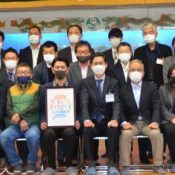
December 2, 2021 Ryukyu Shimpo
By Sakae Toiyama
The Japanese public broadcaster NHK’s newest asadora (morning drama) series Chimudondon (Okinawan for ‘racing heart’) will air next spring. In response, the municipality of Tsurumi Ward in Yokohama City, Kanagawa Prefecture (where the drama’s story is set) has joined forces with the ward’s market and Okinawa Kenjinkai (Okinawan association) to launch the “Tsurumi Yokohama Chimudondon Project.” The project’s executive committee was formed on December 1 and is tasked with promoting Tsurumi Ward while leveraging exposure the national TV series will bring. The committee held its first general meeting at the Okinawa Kenjinkai event hall, Okitsuru Kaikan, in Tsurumi the same day to approve its official logo and the project executive summary.
There was also a meet and greet for project members who will be working with the executive committee members.
Okinawa Bussan Center’s president and Naha City-native Yuta Shimozato was appointed chair of the executive committee. He commented, “The drama series will push Tsurumi into the national spotlight. I look forward to collaborating with everyone to promote Tsurumi and Okinawa.”
The Tsurumi Chimudondon Project’s basic concept is: “Turn Chimudondon fans into Tsurumi Ward fans.” The goal is to revitalize the ward by increasing its recognition through local events linked to the TV series. The executive committee includes members of the Okinawa Kenjinkai; a non-profit organization that supports Japanese Americans; and the ward’s municipal association. Meanwhile, project members come from 26 local companies and organizations, such as JR Tsurumi Station, Keikyu Electric Railway, Yokohama Nakadori Post Office, Kanagawa Toyota Motor Co., and Kanagawa Shimbun.
The official logo of the executive committee includes the inscription: “Tsurumi Yokohama will make your heart race (chimudondon)”, and features designs of the shisa-dog to symbolize Okinawan culture; the samba to symbolize South American culture; and the mascot of Tsurumi Ward. As its next step, the committee plans to create a website, a social media presence, and a PR video.
(English translation by T&CT and Monica Shingaki)
Go to Japanese
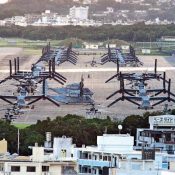
December 2, 2021 Ryukyu Shimpo
By Manato Akira
December 2 marked 25 years since the Japan-U.S. Special Action Committee on Okinawa (SACO) issued its 1996 final report, which established plans such as the return of approximately 5,000 hectares of U.S. military base land in Okinawa and the relocation of training. The report established conditions, such as the transfer of functions or the construction of substitute facilities in Okinawa, for the return of 11 facilties determined by SACO. The base burden has been shuffled around such that the opposite of burden reduction is occurring, and in addition, there is concern that this could lead to longer-term use of facilities and the burden becoming entrenched.
[Collection] Base concerns include successive accidents, use for other than intended purposes
The Japanese government bears costs for returns and relocations based on the final report under the pretense of reducing the base burden on Okinawa. However, this tends to result in convenient facility updates for the U.S. military.
A condition for returning a major portion (approximately 4,000 hectares) of the Northern Training Area (NTA) was to relocate helipads (helicopter landing zones) to the remaining NTA land. Helipads have been constructed so as to crowd around local communities, and the number of times noise outbreaks occur has increased.
70.3% of US exclusive-use facilities throughout Japan are concentrated in Okinawa. Even if all land returns determined by SACO were completely implemented, there would only be a slight drop in this percentage to 69.6%. If the square measure of the Futenma Replacement Facility in Henoko, which was decided upon after SACO, were also included in calculations, the degree of military base concentration in Okinawa would further increase.
Okinawa Governor Denny Tamaki requests a review of SACO, and for the governments of the United States and Japan to come together again for discussions with the addition of Okinawa’s government.
(English translation by T&CT and Erin Jones)
Go to Japanese

December 1, 2021 Ryukyu Shimpo
By Takahiro Shinjo
Nakijin – The sixth graders at Nakijin Kaneshi Elementary School went on a class trip on October 21 and 22. Usually, the pupils go to Naha for a trip that involves an overnight stay, but due to the coronavirus, this year the school decided to stay local for an experience-based trip to “rediscover Nakijin.”
With the help of Churasan Planning, located in Imadomari in Nakijin, the sixth graders got to try making Shisa. Then all of the pupils dressed up in traditional Ryukyu dress and took commemorative photos in front of the Nakijin Castle wall.
Each student got to enjoy wearing traditional clothing in their own way, with some of the boys choosing to wear traditional women’s clothing. Bunta Nakazato says, “Since I had the chance, I wanted to try wearing women’s clothing for the first time. It’s a good memory of one of my last experiences in elementary school. If there’s another chance, I want to come back here and take pictures with everyone again.”
Michiko Yonamine helped plan the trip as a representative of Churasan Planning. “I’m glad that the kids seemed to enjoy themselves,” she says.
(English translation by T&CT and Ellen Huntley)
Go to Japanese
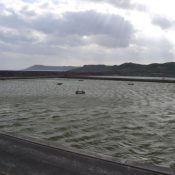
December 2, 2021 Ryukyu Shimpo
By Shinji Sano
Miyakojima – The Miyakojima Fishery Cooperative disclosed December 1 that around 1.4 million kuruma shrimp being raised in an aquaculture farm in the Miyakojima fishing port were almost entirely wiped out by penaeid acute viremia (PAV), also known as white spot disease. According to the co-op, this is the first time in 28 years of raising shrimp where the amount of shrimp shipped will be zero, and that losses look to reach upwards of 100 million yen. It is unclear how the disease made its way through the population of shrimp, and as a result it is also unclear how the farm will be able to restart breeding. Other fisher operators in the town have not reported any similar infections.
The fishery co-op notified Okinawa prefecture on December 2, and a staff member from the Okinawa Prefectural Fisheries Research and Extension Center was dispatched to the scene. A survey will be conducted at the fishery, and then the fishery co-op and Miyakojima city will confer to discuss next steps.
According to Okinawa Prefecture and the Miyakojima Fishery Cooperative, white spot disease only affects crustaceans, and cannot be transmitted to people. Shrimp have been known to exhibit cannibalism, and the disease can spread by shrimp eating other infected shrimp.
The fishery cooperative has been raising kuruma shrimp since 1993. Baby shrimp are purchased from Kume Island, and raised in three fish ponds (each about 14,000 square meters). Each month, samples are sent to the Okinawa Prefectural Fisheries Research and Extension Center to test for disease.
White spot disease was first discovered in the fish pond by the co-op in 2016. Since then, they remove any of the shrimp that have been infected each year, but since this process overlapped with their shipping season (at the end of November), they are able to remove the infected shrimp and ship the rest. However the infection reduces the amount of shrimp they are able to ship, and since 2016 the fishery operation has been in the red.
This year they held off on shipping when the disease was confirmed in October, and it spread explosively from there. Since the first discovery of disease in 2016, Okinawa Prefecture has also been conducting tests, but they are still not sure how the disease has been spreading.
Each year, the fishery co-op drains the ponds of water, stirs up the sand on the bottom and lets it dry under the sun, as well as thoroughly cleans with chlorine. Co-op president Koji Kuriyama sighed, saying “When breeding density is high it can cause stress which can promote disease transmission, so this year we did not use one of the ponds, an reduced the number of shrimp.”
There are concerns that the disease could spread outside of the fishery, so crustaceans in the area around the fishery were captured and tested, but the results came back negative. “We’ve tried everything. The only thing left is to swap out all of the ground sand, but this would be an enormous expense, and we cannot be sure that this would eliminate the disease.”
(English translation by T&CT and Sam Grieb)
Go to Japanese
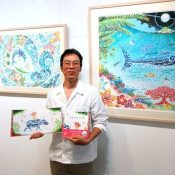
November 29, 2021 Ryukyu Shimpo
By Takeshi Kishimoto
Okinawa – Masayuki Yogi, 47, who creates “Ryukyu Illustrations” depicting images of southern Japan using a computer, is approaching his fifth year at the Soranoe art gallery and workshop on Palmyra Street in Okinawa City. His work has made its way throughout Japan, attracting fans at exhibitions all over the country.
After graduating from the Okinawa Prefectural University of Arts with a major in design, Yogi worked in Tokyo as a graphic designer. However, it never gave him a sense of accomplishment, so he returned to Okinawa when he was 29.
He poured himself into his pictures while working as a freelancer, devoting himself to his craft. He created his illustrations with influences from traditional art such as Bingata, Raden, Ukiyo-e and Jomon pottery, blending them with the powerful natural features of Okinawa and the southern islands, constructing a unique view of the universe.
Yogi draws Okinawan animals such as whales, tropical fish, and Okinawa rail with a pencil or pen in a unique form, then uses a computer to add vivid colors. Then, he prints the images using a high-color, high-tolerance inkjet printer.
His works, which overflow with southern Japanese imagery, started to attract attention, and were used for a long time on the covers of Okinawan prefectural and city PR brochures, as well as in collaboration with major Okinawan manufacturers. In addition to the publication of a picture book with no words featuring his unique images, he strove to expand into making other goods.
In recent years he has held exhibitions in places such as Tokyo, Kanagawa, Chiba, Saitama, Kyoto, and Nara, and even Taiwan, attracting a large number of fans in the process.
People who have purchased his works have given a variety of reactions such as, “It gives a moving, calm feeling,” “It brightens up the room,” “I can sink into the world of the art for hours on end.” Yogi says, “Nothing makes me happier as an artist than making people excited, exhilarated.”
Yogi, who originates from Naha, wanted a mental escape from the hustle and bustle of “mini-Tokyo,” and while he wound up with a studio in the middle of Okinawa City’s main commercial area, he burst into a smile saying, “I’ve grown to appreciate Koza culture.”
The gallery is actively looking for young artists, “to be a home for art, and to invigorate the town,” by breathing new life into it. For inquiries, call 098 (988) 7848.
(English translation by T&CT and Sam Grieb)
Go to Japanese
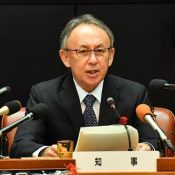
November 26, 2021 Ryukyu Shimpo
On November 25, the Okinawa Prefectural Government (OPG) decided to reject the Okinawa Defense Bureau’s (ODB’s) design change application for soft seafloor improvement work pertaining to construction of the Futenma Replacement Facility in Henoko, Nago City. The OPG made this decision because of deficiencies in the investigation of the soft seafloor and because the measures for environmental conservation are inadequate. The OPG informed the ODB of its decision on the same day. On the evening of the same day, Governor Denny Tamaki held a press conference and stated that originally, the ODB “did not carry out the minimum level of geotechnical investigation necessary prior to starting in on the project, and plunged forward while there were still uncertainties involved.” He thinks that the entire scope of land reclamation, including the construction that is currently underway, should be suspended.
[Reasoning behind the rejection] Why use this “trump card” now?
Due to the OPG rejecting the design change, the ODB will not be able to carry out construction where the soft seafloor is present, which is on the Oura Bay side of the construction zone. It is likely that the ODB will take countermeasures such as making a formal objection based on the Administrative Appeal Act in order to nullify the OPG’s rejection. Thereafter, it is likely that the OPG will claim that these countermeasures are illegal, and a court battle will ensue.
According to the OPG, the written design change application does not make use of data obtained through the direct examination of the deepest point underwater of the soft seafloor in the ocean area planned for land reclamation, where the soft seafloor is approximately 90 meters underwater, and, as such, “no examination has carried out with adequate consideration to disaster prevention.”
Additionally, there has been no underwater sound investigation into the construction’s effects on the dugong, and, as such, the examination of environmental conservation measures has not been sufficient.
Governor Tamaki spoke about the use of soil from the southern part of Okinawa Island, in which the remains of war dead from the Battle of Okinawa may be present, saying, “There are many prefectural citizens and national citizens who feel apprehension, resentment, and sorrow due to land reclamation being forced through unilaterally and in a heavy-handed manner without an adequate explanation.”
Governor Tamaki also pointed out that if deficiencies in the investigations and procedures pursued by the ODB dramatically lengthen the construction period, land reclamation will become impossible to complete, and not only that, it has become impossible to avoid incurring enormous costs exceeding initial estimates.
According to the ODB, at 4:40 p.m. on November 25, it received written notice about the rejection from OPG personnel. When asked in an interview, a spokesperson for the ODB said that, “First, we will carefully examine the reasoning behind the rejection.”
(English translation by T&CT and Erin Jones)
Go to Japanese

November 25, 2021 Ryukyu Shimpo
One of Japan’s largest food industry expos, “The Great Okinawa Trade Fair 2021” (hosted by the event’s executive committee) was held November 25 at the Hotel Collective in Naha. For the first time the event implemented a hybrid model, with online meetings starting as early as August, combined with in-person meetings at the event. For two days November 25-26, 13 companies from Okinawa in addition to 92 other suppliers displayed their wares, and 59 buyers, including 29 domestic companies and 30 exporters participated in the event.
Up through 2019 the event had always taken place in person, but the coronavirus pandemic in 2020 required them to host the event online that year. The executive committee announced that as of the closing of the exposition, 30% of in person meetings resulted in a contract (including estimates), while online meetings resulted in a contract at a rate of 17.1%.
On the first day of the event, 52 suppliers held meetings and displayed their goods in two different meeting halls, and on the second day 53 suppliers also exhibited their products.
(English translation by T&CT and Sam Grieb)
Go to Japanese
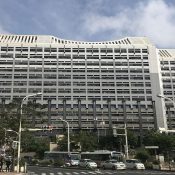
November 26, 2021 Ryukyu Shimpo
On November 25, the Novel Coronavirus Response Headquarters of Okinawa held a meeting and, in light of the improved situation in the prefecture, lowered the coronavirus alert level to level 1 for the first time since July 2020. As a result of an early reevaluation of the current response plan, which originally extended through the end of November, the group lifted restrictions on communal dining, such as the four-attendee and two-hour limits. On the condition that an infection prevention and safety plan is submitted to the prefecture, restrictions on numbers of participants at events have also been lifted. The meeting highlighted a “return to normal”.
Until now, the prefecture has published a “response plan” for a set period, summarizing measures to be taken to prevent the spread of the virus. However, at this meeting, the response team changed the name to a “baseline plan” and did not specify the effective period. While the restrictions on the length of time for dining together have been lifted, prefectural representatives ask Okinawans to refrain from activities involving increased risk of infection such as dining with large groups or for long periods of time. They also ask that large gatherings be held only among fully vaccinated individuals or individuals with a negative covid test.
Previously, events with at least 5000 attendees were required to limit attendance to half the capacity of the venue. However, on the condition that the organizers submit a plan to the prefecture that includes thorough measures to prevent airborne spread of the virus and to enforce hand sanitizing, full-capacity events will now be allowed. Half-capacity restrictions will continue to apply to events where there will be continuous use of loud voices.
The team also shared alert guidelines in case of future increases in infections, including plans to issue warnings at the municipal or health center level if new infections in the area surpass 25 per 100,000 people in a single week. In areas subject to such a warning, communal dining will be restricted to no more than four people, for no longer than two hours.
With Coming-of-Age ceremonies and the like approaching, the prefectural government asks local governments to encourage attendees to get vaccinated and get a PCR test before events.
At the meeting, Okinawa’s Chief Medical and Health Officer, Toru Itokazu said “We are asking Okinawans for their continued cooperation so that we can maintain the current improved situation.”
(English translation by T&CT and Ellen Huntley)
Go to Japanese

November 25, 2021 Ryukyu Shimpo
Okinawa Prefecture—On November 24, an MV-22 Osprey belonging to U.S. Marine Corps Air Station Futenma dropped a stainless-steel water bottle mid-flight, which landed on a residential area in Nodake, Ginowan City. The canteen, obliterated from the impact of the fall, no longer retained its original shape. Residents were shocked and terrified by the possibility of the item striking a person. However, it was business as usual for the U.S. military, which continued its flight exercises on November 24. Such accidents have plagued Okinawa from before its reversion to Japan and past promises of “preventing recurrence” have proved to be an empty one. Residents voiced their outrage at the disregard for their lives.
Just after 6:00 p.m. on November 23, a loud bang echoed through the residential area of Nodake 2-chome, Ginowan City. A metal water bottle hit the ground, bounced, and landed on the porch of a nearby home. The bottom of the bottle burst, and the sides were severely dented. Pieces of the canteen were found scattered on the street.
The scene, located about 200 meters from Futenma Air Station, is a quiet suburban area where residents enjoy strolls and children play outdoors on weekends.
The resident noticed the object in front of her front door when she arrived home around 11:00 p.m. The crumpled canteen still held some water and had a sticker on the outside, which the resident found unusual. She deduced it originated from a foreign county and likely fell from the sky based on its appearance, and immediately contacted a city councilor she knew.
The next day, despite it being a Japanese national holiday (Labor Day), the U.S. military continued to fly aircraft well past 10:00 p.m. (one plane landed at Futenma Airfield at 10:20 p.m.), the cut-off time stipulated in the Japan-U.S. aircraft noise abatement agreement.
“We would’ve had a big problem if the canteen had struck a civilian passerby or car,” said the resident. The city councilor who arrived at the scene the following day expressed relief, commenting, “It was a large canteen, so I’m really glad no one was hurt.”
The quiet suburb was thrown into chaos as police and news reporters swarmed the scene on the morning of November 24.
The resident on the scene pleaded, “I want a proper investigation so that something like this will never happen again.” Meanwhile, large CH-53E transport helicopters and Ospreys continued to fly overhead.
(English translation by T&CT and Monica Shingaki)
Go to Japanese
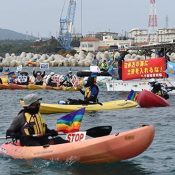
November 22, 2021 Ryukyu Shimpo
The “33rd Tada Yoko Anti-Authority Human Rights Award,” which is bestowed on individuals and organizations for battling political authorities and protecting human rights, was awarded to the “Helipad opposition maritime team,” who have been protesting the new base construction in Henoko, which is part of the relocation of MCAS Futenma. The award’s financial steering committee announced the award on their homepage on November 16.
In 2005 the 17th bestowment of the award was won by the “Helipad Opposition Conference,” which worked to oppose the base construction plan.
The award’s financial committee recognized the maritime team’s resistance against unjust restrictions and oppression, while working to halt the base construction in canoes and protest boats with the help of on-shore support.
Koushin Nakamoto, 73, the director-general of the Helipad Opposition Conference, which includes the maritime team, said, “We were acknowledged for our tenacious non-violent fight on the water. We want to continue to win the encouragement of the people of Okinawa, disallow the continued landfilling activity, and protect our abundant nature.”
(English translation by T&CT and Sam Grieb)
Go to Japanese











 Webcam(Kokusai Street)
Webcam(Kokusai Street)


